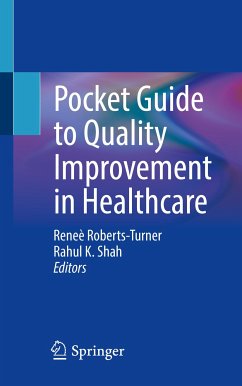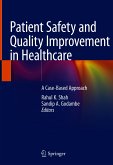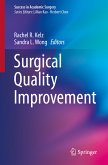Pocket Guide to Quality Improvement in Healthcare (eBook, PDF)
Redaktion: Roberts-Turner, Reneè; Shah, Rahul K.


Alle Infos zum eBook verschenken

Pocket Guide to Quality Improvement in Healthcare (eBook, PDF)
Redaktion: Roberts-Turner, Reneè; Shah, Rahul K.
- Format: PDF
- Merkliste
- Auf die Merkliste
- Bewerten Bewerten
- Teilen
- Produkt teilen
- Produkterinnerung
- Produkterinnerung

Hier können Sie sich einloggen

Bitte loggen Sie sich zunächst in Ihr Kundenkonto ein oder registrieren Sie sich bei bücher.de, um das eBook-Abo tolino select nutzen zu können.
This text will act as a quick quality improvement reference and resource for every role within the healthcare system including physicians, nurses, support staff, security, fellows, residents, therapists, managers, directors, chiefs, and board members. It aims to provide a broad overview of quality improvement concepts and how they can be immediately pertinent to one's role. The editors have used a tiered approach, outlining what each role needs to lead a QI project, participate as a team member, set goals and identify resources to drive improvements in care delivery. Each section of the book…mehr
- Geräte: PC
- ohne Kopierschutz
- eBook Hilfe
- Größe: 4.82MB
![Disruptive Healthcare Provider Behavior (eBook, PDF) Disruptive Healthcare Provider Behavior (eBook, PDF)]() Rade B. VukmirDisruptive Healthcare Provider Behavior (eBook, PDF)40,95 €
Rade B. VukmirDisruptive Healthcare Provider Behavior (eBook, PDF)40,95 €![Patient Safety and Quality Improvement in Healthcare (eBook, PDF) Patient Safety and Quality Improvement in Healthcare (eBook, PDF)]() Patient Safety and Quality Improvement in Healthcare (eBook, PDF)121,95 €
Patient Safety and Quality Improvement in Healthcare (eBook, PDF)121,95 €![Intervention Effectiveness Research: Quality Improvement and Program Evaluation in Healthcare (eBook, PDF) Intervention Effectiveness Research: Quality Improvement and Program Evaluation in Healthcare (eBook, PDF)]() Karen A. MonsenIntervention Effectiveness Research: Quality Improvement and Program Evaluation in Healthcare (eBook, PDF)46,95 €
Karen A. MonsenIntervention Effectiveness Research: Quality Improvement and Program Evaluation in Healthcare (eBook, PDF)46,95 €![Surgical Quality Improvement (eBook, PDF) Surgical Quality Improvement (eBook, PDF)]() Surgical Quality Improvement (eBook, PDF)40,95 €
Surgical Quality Improvement (eBook, PDF)40,95 €![The Field Guide to Rapid Process Improvement Workshops in Healthcare (eBook, PDF) The Field Guide to Rapid Process Improvement Workshops in Healthcare (eBook, PDF)]() Cameron StarkThe Field Guide to Rapid Process Improvement Workshops in Healthcare (eBook, PDF)54,95 €
Cameron StarkThe Field Guide to Rapid Process Improvement Workshops in Healthcare (eBook, PDF)54,95 €![Intervention Effectiveness Research: Quality Improvement and Program Evaluation (eBook, PDF) Intervention Effectiveness Research: Quality Improvement and Program Evaluation (eBook, PDF)]() Karen A. MonsenIntervention Effectiveness Research: Quality Improvement and Program Evaluation (eBook, PDF)36,95 €
Karen A. MonsenIntervention Effectiveness Research: Quality Improvement and Program Evaluation (eBook, PDF)36,95 €![Hospital Medicine (eBook, PDF) Hospital Medicine (eBook, PDF)]() Hospital Medicine (eBook, PDF)69,95 €
Hospital Medicine (eBook, PDF)69,95 €-
-
-
Dieser Download kann aus rechtlichen Gründen nur mit Rechnungsadresse in A, B, BG, CY, CZ, D, DK, EW, E, FIN, F, GR, HR, H, IRL, I, LT, L, LR, M, NL, PL, P, R, S, SLO, SK ausgeliefert werden.
- Produktdetails
- Verlag: Springer International Publishing
- Seitenzahl: 333
- Erscheinungstermin: 21. Mai 2021
- Englisch
- ISBN-13: 9783030707804
- Artikelnr.: 61929690
- Verlag: Springer International Publishing
- Seitenzahl: 333
- Erscheinungstermin: 21. Mai 2021
- Englisch
- ISBN-13: 9783030707804
- Artikelnr.: 61929690
- Herstellerkennzeichnung Die Herstellerinformationen sind derzeit nicht verfügbar.







